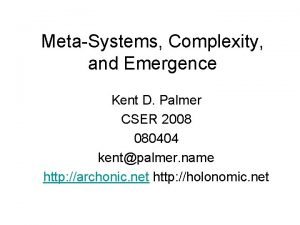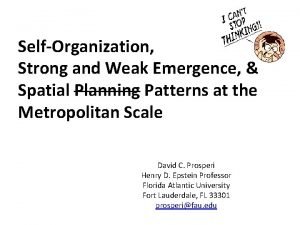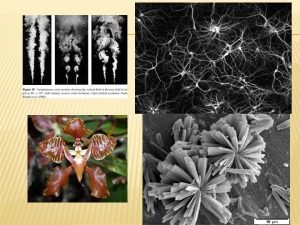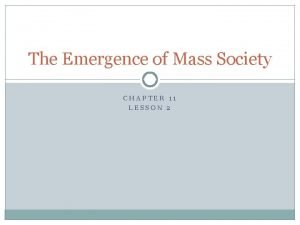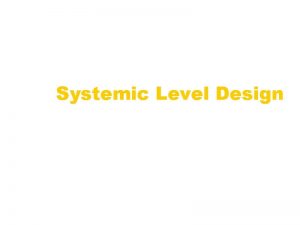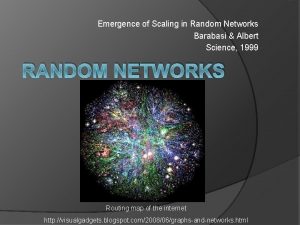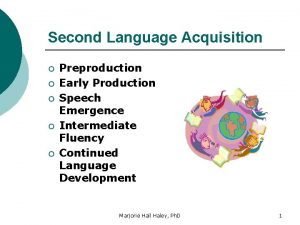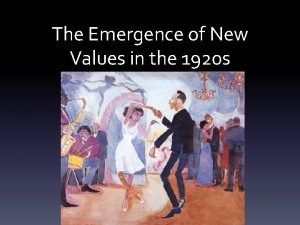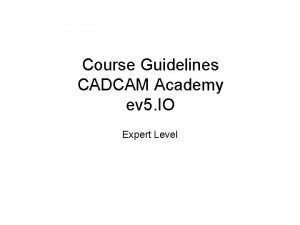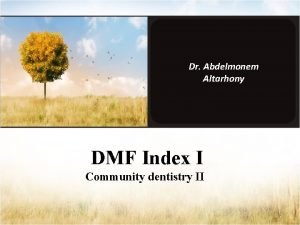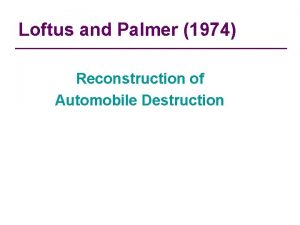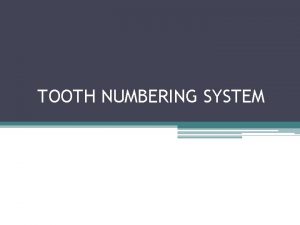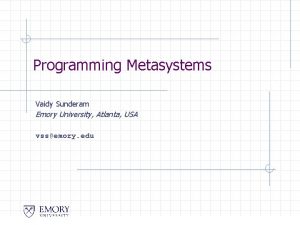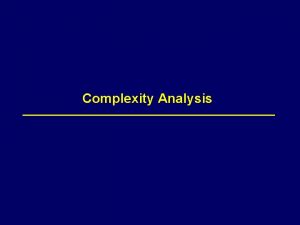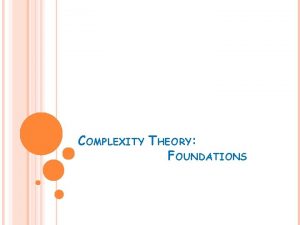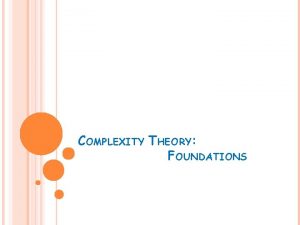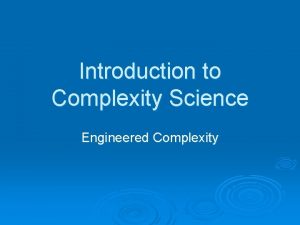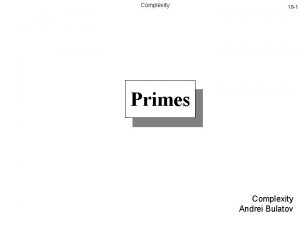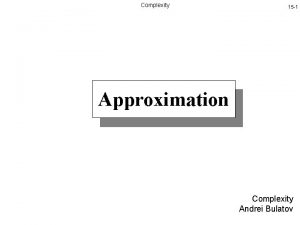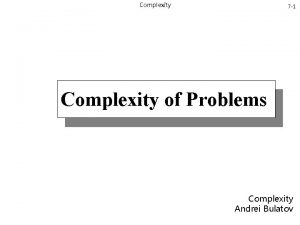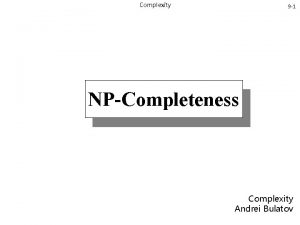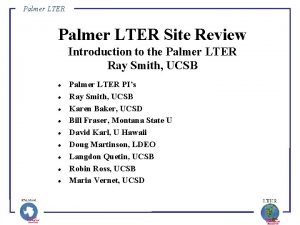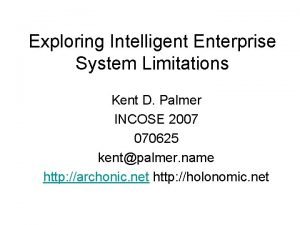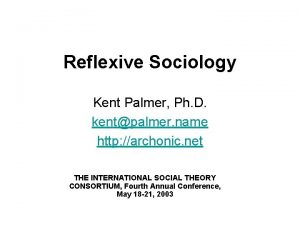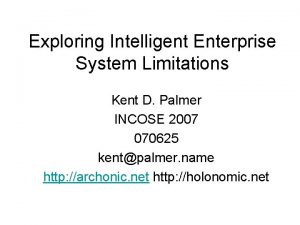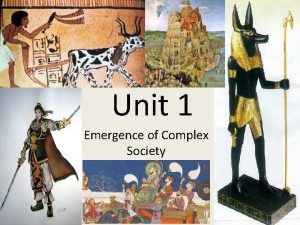MetaSystems Complexity and Emergence Kent D Palmer CSER




























- Slides: 28

Meta-Systems, Complexity, and Emergence Kent D. Palmer CSER 2008 080404 kent@palmer. name http: //archonic. net http: //holonomic. net

Papers for CSER Conference • The Failure of Systems Engineering as an approach toward Complex Adaptive Systems in our major Customer’s Eyes: – Analysis of the Capstone Concept for Joint Operations and its relation to Meta-systems Theory • Emergence and Complexity in relation to General Schemas Theory – A point of discussion within the Systems Science Enabler Technical Working Group of INCOSE

Meta-system Primer • This brief primer will help readers to understand the papers associated with this conference • In order to understand the points of my paper it is necessary to explain Metasystems in relation to Systems • Meta-systems offer a different way to look at things than Systems

Two different Schemas Meta-System ≠ System of Systems (Super-system) System Sub-system

What is a Schema • A projected organization of envelopes of spacetime which is a template for the pre-understanding of perceptual objects • The term “System” is over-used and has lost its meaning. To get that meaning back we must compare it with other similar concepts of the same type that have a family resemblance but at different scales • The history of the term Schema is discussed by Umberto Eco in Kant and the Platypus – By Schema we mean what he calls the “Mathematical and Geometrical Schemas, ” not the many other meanings of the term he mentions. This is the most basic type of schema, i. e. the type that allows us to reference an object in spacetime.

System and Meta-system Formalization System “Application” Normal Turing Machine System dynamics with negative feedback Meta-system “Operating System” Universal Turing Machine System dynamics with positive feedback Turning Machine Representation (Gurevich Abstract State Machine)

Bataille “Accursed Share” • • General Economy Meta-system International waters Lawlessness of the high seas • Piracy, reflaging ships, contraband smuggling • Restricted Economy • System • Nation states control what is within their borders, ideally • Really the state is a meta-system inside = black and grey markets, barter and gift

Nested Systems and Meta-systems Russian Dolls: Shells are systems Spaces are meta-systems

Meta-system Characteristics + Positive Feedback + Folds continuity and discontinuity (Rene Thom Catastrophe Theory) Negative feedback loop Singularity > SYSTEM - Positive Feedback -

Meta-System Partitions Boundary Horizon System ARENA Origin Sink Anti-System Source

Perceptual / Conceptual • Gestalt – System • Flow – Process • Proto-gestalt – Meta-system • Proto-flow – Meta-process

Open-Scape HORIZON G PG G No movement One point of view PG=Proto-gestalt G= Gestalt

Gestalt vs Flow Background Reference in background foreground Flowing In Foreground

Proto-gestalt / Proto-flow Bank Streams in a River G PG PF view G G F view vie F F w G F Static-dynamic Dynamic-Static Bank PF=Proto-flow F= Flow Reference Line

Emergence and Complexity are Orthogonal • It is possible to have both simplicity and Emergence, such as in atoms • It is possible to have both complexity and de-emergence which some call complications. • We normally see dynamic complexity leading to emergent effects but this is not an intrinsic relation between the two properties

Complex systems do not capture the concept of the meta-system Systems Theory Meta-systems Theory Complex Systems Complex Meta-systems Complex Adaptive Systems Complex Adaptive Metasystems Chaotic Systems Chaotic Meta-systems

Emergence and Schemas are Orthogonal • Any Schema (System or Meta-system) can either be seen as emergent or de-emergent • De-emergence or Emergence can be upward or downward in the self-nesting of a single schema • The transition to another schema from a particular schema can either be emergent or supervenient • Supervenience means homeomorphic without new emergent properties appearing • Sub-venience is mapping in the opposite direction, down instead of up

n be tw a m tio n he si an Tr Complexity START Complication Set to Set or Mass to Mass Transition Simplification Supervenience Subvenience Set to Mass Transition r-S N S es ch ub em tin -s c g he a of m a Sc he m as pe sc a- et Reduction Su ee a m he Sc M Emergence De-Emergence Sc he m as Essential Difference as Novelty Homeomorphism Pick: Position in Hierarchy of Schemas Complexity/Complication ratio Sameness/Difference ratio

as Set to Set or Mass to Mass N es tin g of Sc h em Final Design as m Sc he n ee tw tio n be Alternative Design si Initial Design Homeomorphism Alternative Design Tr an Essential Difference Exploring the Design Landscape Set to Mass Transition

SE should be grounded on Systems Theory Systems Engineering Discipline Systems Theory

Complementary Disciplines Emergent Engineering Systems Engineering Discipline Meta-systems Engineering Discipline Systems Theory Meta-systems Theory

Emergent Engineering Produces EXCESS Emergence or LACK De-emergence Regardless of Schema

System/Meta-system vs Emergence/De-emergence Next higher or lower level of system Emergent System De-emergent System Move to the inner environment Move to the outer environment De-emergent Meta-system Emergent Meta-System An environment with emergent properties of its own without becoming a system

Hierarchy of Schemas Scaffolding Experiential Pluriverse Kosmos World Domain Meta-system Reflexive social Autopoietic Symbiotic Dissipative Ordering System Form Pattern Monad Facet Emergent Engineering deals with all the schematic levels within reach of experience

Schemas and Dimensions infinity Heterochronic 12 --14 String Theory 10 -- 11 Pluriverse Kosmos World Domain Meta-system System Form Pattern Hyper-sphere volumes Monad and areas Facet 8 to 9 7 to 8 Max area 6 to 7 5 to 6 Max volume 4 to 5 3 to 4 2 to 3 1 to 2 0 to 1 -1 to 0 General Rule: Two dimensions per Schema and Two Schemas per dimension

Holonomic Systems Meta-system = Whole less than the sum of its parts Reflexive Autopoietic Special System = Whole exactly equal to sum of parts Dissipative System = Whole greater than sum of is parts

Emergent Meta-system Lower Energy Real Algebra Complex Algebra << lost associative << lost commutative Quaternion Algebra Octonion Algebra Sedenion Algebra Zero Divisors << lost division <<lost conjugate

Meta-system Primer End Kent D. Palmer kent@palmer. name http: //archonic. net http: //holonomic. net
 Kent palmer
Kent palmer Time space complexity of algorithm
Time space complexity of algorithm So&e
So&e Emergence theory
Emergence theory Lesson 2 the emergence of mass society
Lesson 2 the emergence of mass society Systemic game design
Systemic game design Speech emergence stage activities
Speech emergence stage activities Emergence of scaling in random networks
Emergence of scaling in random networks Preproduction early production speech emergence
Preproduction early production speech emergence Plan emergence madagascar 2019-2023 pdf
Plan emergence madagascar 2019-2023 pdf Netflix core competencies
Netflix core competencies Emergence of entrepreneurial class in india
Emergence of entrepreneurial class in india The emergence of new values
The emergence of new values Plan emergence madagascar 2019-2023
Plan emergence madagascar 2019-2023 Itero göteborg
Itero göteborg Landmarks in emergence of corporate governance
Landmarks in emergence of corporate governance The emergence of mass society
The emergence of mass society Dmf dentistry
Dmf dentistry Loftus and palmer (1974)
Loftus and palmer (1974) Bachman and palmer 1996
Bachman and palmer 1996 Ksas apply online
Ksas apply online Health education kent surrey and sussex
Health education kent surrey and sussex Careers and employability kent
Careers and employability kent Scoliometer
Scoliometer Nikki palmer verizon
Nikki palmer verizon Teeth numbering system
Teeth numbering system Sue palmer non chronological report book
Sue palmer non chronological report book Sue palmer recount
Sue palmer recount Sue palmer skeletons
Sue palmer skeletons
